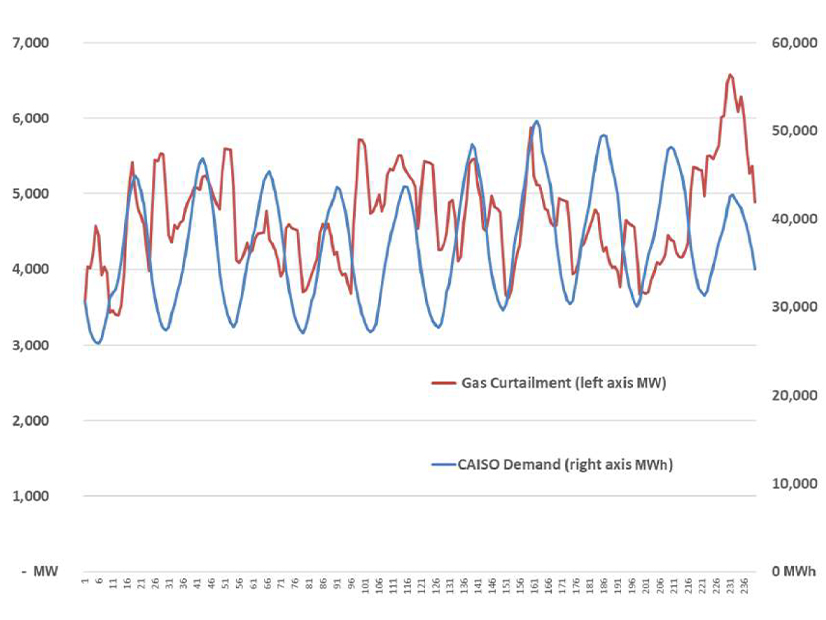
California’s gas-fired power plants experienced a surge in curtailments during last summer’s heat wave, according to a new report, which questions whether the facilities are a solution to preventing energy shortfalls.
At the same time, the gas plants’ emissions spiked, worsening air quality in disadvantaged communities, according to the report, released Wednesday by Regenerate California. The group is a coalition led by the California Environmental Justice Alliance (CEJA) and the Sierra Club.
“Gas simply does not do its job when it matters most,” said Ari Eisenstadt, energy equity manager at CEJA. “Gas plants’ mythical reliability value in keeping the lights on is far outweighed by their negative air quality impacts for environmental justice communities.”
Regenerate California partnered with consultant Grid Strategies to analyze power output and emissions from 107 gas plants in California during the record-breaking heatwave from Aug. 31 to Sept. 9, 2022.
Potential generation that was lost due to gas plant outages and derates during the heat wave totaled more than 1.1 million MWh, or nearly 5,000 MW on average, according to the analysis, which used CAISO data.
And during the peak period from 4 to 9 p.m., curtailments were about 200 MW higher on average.
“California gas plant curtailments track fairly closely with CAISO hourly demand during the heat wave, likely reflecting that derates due to high ambient temperatures coincide with periods of high electricity demand,” the report said.
The report didn’t include curtailment data from days outside of the heat wave. But Grid Strategies Vice President Michael Goggin said a standard assumption is that about 5% of the gas fleet will be unavailable during peak periods.
In contrast, a curtailment of 10% or even as much as 15% was seen at peak periods during last year’s heat wave, Goggin said Wednesday during a media briefing on the report.
That was due to gas plants running less efficiently when the weather heats up, along with an increase in equipment failures, Goggin said. Older plants that were fired up during the heat wave were less reliable, he added.
“It’s pretty clear that these gas plants fell well short of what was expected of them,” Goggin said.
When asked to comment on the report, a spokesperson with the Edison Electric Institute, which represents U.S. investor-owned electric companies, said EEI members are working to deploy wind, solar and energy storage resources while demonstrating technologies that aren’t yet available at cost and scale.
“As we continue to deploy those resources, nuclear energy and natural gas generation are essential partners in accelerating the clean energy transition,” EEI media relations director Sarah Durdaller told RTO Insider. “They allow our member companies to integrate more renewables into the energy grid while ensuring resilience and reliability.”
Emissions Spike
The report also examined gas plant emissions using data from EPA’s continuous emissions monitoring program. For the 107 plants for which EPA data were available, emissions of sulfur dioxide, nitrogen oxides and carbon dioxide increased by about 60% during the heat wave compared with a baseline period of Aug. 19-28, 2022.
Not only did overall emissions increase, but emissions per megawatt-hour were also up as older plants came online, Goggin said.
“There were some very dirty power plants that turned on during these really top hours of need,” he said.
The increased emissions came after Gov. Gavin Newsom issued an emergency proclamation at the start of the heat wave, loosening air quality requirements to allow gas-fired power plants to generate more electricity. (See Newsom Declares Emergency as Heat Stresses Calif. Grid.)
Blackouts Avoided
CAISO was able to avoid rolling blackouts during the heat wave, despite demand reaching a new high of more than 52 GW on Sept. 6. Several factors helped prevent a blackout, the ISO said, including an emergency text message sent out to 27 million cell phones on Sept. 6 urging consumers to conserve electricity. Within 20 minutes of the 5:45 p.m. alert, demand plunged by 2,385 MW. (See CAISO Reports on Summer Heat Wave Performance.)
“That’s really what kept the lights on,” Eisenstadt of CEJA said during Wednesday’s media briefing. “If we were paying people to do that — especially if we were paying low-income ratepayers to do that — the effect would be massive.”
Eisenstadt and others called on the state to fund clean energy projects rather than keeping gas plants going.
“We must invest in demand-side solutions and drive local clean energy buildout in environmental justice communities to improve air quality and ensure grid reliability,” said Teresa Cheng, senior campaign representative with the Sierra Club.
And Eisenstadt said the dense snowpack from California’s unusually wet winter — with its expected boost to hydropower this summer — gives the state a window of opportunity to move away from gas power plants to greener forms of energy.
Some older gas plants that were slated for closure now may be kept in service as part of the Strategic Reliability Reserve that the state developed last year as part of Assembly Bill 205.
For example, AES Corp. announced in April that it signed agreements with the California Department of Water Resources to extend operations of once-through cooling units at its Huntington Beach and Alamitos gas plants through 2026. The units had been scheduled to stop operating in December 2023.
Units at Huntington Beach and Alamitos made it onto a list in the Regenerate California report of the top 15 gas plants ranked by megawatt-hours of curtailment during the heat wave.
If the three-year extensions for the 1.4 GW at Huntington Beach and Alamitos are approved, AES will run the units during emergency grid reliability events within the Strategic Reliability Reserve Program, the company said.
“Our Southland legacy units continue to demonstrate that they are ready and able to support the reliability of California’s electric grid,” Andrés Gluski, AES president and CEO, said in a statement at the time.
